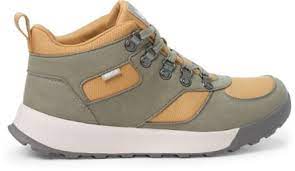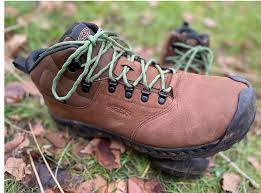
Are you ready to find the perfect fit for your feet? Look no further than Oboz hiking boots. With their durable construction and comfortable design, Oboz boots are the ideal choice for your outdoor adventures.
In this article, we will guide you through the process of discovering the right fit for your feet. From understanding Oboz sizing to exploring different boot features, we’ve got you covered.
Get ready to hit the trails with confidence in your new Oboz boots!
The Importance of Proper Fit
When it comes to Oboz hiking boots, finding the right fit for your feet is crucial for a comfortable and enjoyable outdoor adventure. Proper fit ensures that your feet are supported and protected, reducing the risk of blisters, hotspots, and discomfort.
Ill-fitting boots can cause unnecessary strain on your feet, leading to fatigue and potentially ruining your hiking experience. Oboz understands the importance of a proper fit, which is why they offer a wide range of sizes and widths to accommodate different foot shapes.
Their boots also come with adjustable lacing systems and removable insoles, allowing you to customize the fit to your liking. Remember, when trying on Oboz hiking boots, make sure to wear the socks you’d typically wear on your outdoor excursions to ensure an accurate fit.
Don’t compromise on fit – your feet will thank you!
Understanding Oboz Sizing
To understand Oboz sizing, measure your feet with a ruler or tape measure. This step is essential in finding the right fit for your hiking boots. Start by placing your foot on a piece of paper and tracing the outline. Measure the length from the heel to the longest toe, and the width at the widest part of your foot.
Once you have these measurements, refer to the Oboz sizing chart to determine your size. Keep in mind that Oboz offers both men’s and women’s sizes, so make sure to choose the correct chart.
It’s also important to note that Oboz boots are designed to provide a roomy toe box and a snug heel fit, allowing for a comfortable and secure hiking experience.
Differentiating Between Men’s and Women’s Styles
Differentiating between men’s and women’s styles is crucial when selecting the right fit for your Oboz hiking boots, as it ensures that you choose the appropriate design for your specific needs and preferences.
Oboz offers distinct styles for men and women, taking into account the differences in foot shape and size. Men’s styles are typically wider and have a larger toe box to accommodate the broader foot shape.
On the other hand, women’s styles are narrower and have a more contoured shape to fit the narrower female foot. Additionally, women’s styles often feature a lower volume in the heel area to prevent slippage.
Exploring Oboz Boot Features
As you explore the features of Oboz hiking boots, you’ll discover a range of innovative design elements that enhance performance and comfort on the trails.
Oboz boots are built with a purpose, combining durability and functionality to provide the best hiking experience.
One notable feature is the Granite Peak outsole, which offers excellent traction on various terrains, ensuring stability and grip.
Another key element is the B-DRY waterproofing technology, keeping your feet dry and comfortable even in wet conditions.
The O FIT Insole™ provides exceptional support, cushioning, and arch alignment, reducing fatigue and promoting proper foot alignment.
Additionally, Oboz boots are constructed with a rugged yet lightweight design, using high-quality materials that withstand the demands of the trail.
With these features, Oboz hiking boots are engineered to optimize your performance and keep your feet happy during your outdoor adventures.
Determining Your Foot Type
When determining your foot type, there are two important factors to consider: arch support options and pronation.
Arch support options help provide stability and reduce strain on your feet, while pronation refers to the natural movement of your foot as you walk or run.
Understanding your arch type and pronation pattern will help you find the right hiking boots that offer the necessary support and stability for your feet.
Arch Support Options
Find out which arch support option suits your foot type best.
When it comes to choosing the right arch support for your hiking boots, it’s important to understand your foot type. There are three main types of foot arches: high arches, normal arches, and low arches.
If you have high arches, you’ll need a hiking boot with a higher arch support to provide the necessary stability and cushioning. On the other hand, if you have low arches, you’ll benefit from a hiking boot with a lower arch support that offers more flexibility and support.
For those with normal arches, a medium arch support option is usually suitable. By determining your foot type and choosing the appropriate arch support option, you can ensure a comfortable and enjoyable hiking experience.
Pronation and Stability
To determine your foot type and understand your pronation and stability, assess how your foot lands and rolls while walking or running. This will help you determine if you have neutral pronation, overpronation, or underpronation.
Neutral pronation means that your foot lands on the outside of the heel and rolls inward slightly to absorb shock.
Overpronation occurs when your foot rolls too far inward, putting excessive pressure on the inside of the foot.
Underpronation, also known as supination, happens when your foot doesn’t roll inward enough, causing the outside of the foot to bear the majority of the weight.
Understanding your foot type and pronation is crucial in finding the right hiking boots that provide the necessary stability and support for your feet.
Trying On Oboz Boots: Tips and Tricks
Before trying on Oboz boots, make sure you have your own hiking socks. Having the right socks is crucial when trying on any type of footwear, especially hiking boots. Hiking socks are designed to provide extra cushioning, moisture-wicking, and support, which are essential for a comfortable hiking experience.
When trying on Oboz boots, it’s important to wear the same type of socks that you’d wear on your hikes to ensure an accurate fit. Once you have your socks on, loosen the laces and slide your foot into the boot. Make sure your heel is snugly positioned in the back and your toes have enough room to wiggle.
Walk around in the boots to assess their comfort and fit. Pay attention to any pressure points or areas of discomfort. Remember, finding the perfect fit may take some time, so don’t rush the process.
Addressing Common Fit Issues
Are you experiencing discomfort in the toe area of your Oboz hiking boots?
Do you find that your arches aren’t properly supported?
These common fit issues can be addressed to ensure a more comfortable and enjoyable hiking experience.
Let’s explore some solutions to narrow toe boxes and arch support problems.
Narrow Toe Box
If you have narrow feet, finding hiking boots that provide a comfortable fit can be a challenge. One common fit issue that narrow-footed hikers often encounter is a narrow toe box. The toe box refers to the front part of the shoe that accommodates your toes. When the toe box is too wide, it can cause your feet to slide forward, leading to discomfort and blisters.
To address this issue, it’s important to look for hiking boots with a narrow toe box. Oboz offers a range of hiking boots specifically designed for narrow feet, with a snug fit that prevents your feet from moving around inside the shoe. These boots provide the necessary support and stability while ensuring a comfortable fit for your narrow feet.
Arch Support Problems?
To ensure proper comfort and stability while hiking, it’s essential to find hiking boots with adequate arch support. Arch support problems can lead to discomfort and pain, making your hiking experience less enjoyable.
When your arches aren’t properly supported, it can cause your feet to roll inward or outward, leading to imbalances and potential injuries. If you have high arches, you may experience excessive pressure on the balls and heels of your feet. On the other hand, flat feet can cause overpronation, which can strain your arches and cause pain.
To address these common fit issues, look for hiking boots that offer good arch support. This will help distribute your weight evenly and provide stability, reducing the risk of discomfort and injury while hiking.
Making the Final Decision: Choosing Your Perfect Oboz Fit
Choose the perfect fitting Oboz hiking boots by following these simple steps.
First, measure your feet using a Brannock device or a ruler. Take note of both the length and width of your feet.
Next, determine your foot shape – whether you have high arches, low arches, or neutral arches. This will help you select the right type of Oboz boots that provide the necessary support.
Then, try on different sizes and models of Oboz boots. Walk around the store and pay attention to how they feel on your feet. Look for any areas of discomfort or pressure points.
Frequently Asked Questions
Yes, you can wear Oboz hiking boots for other outdoor activities besides hiking. They are versatile and designed for various terrains, ensuring comfort and protection whether you’re camping, backpacking, or engaging in other outdoor adventures.
Yes, Oboz boots are suitable for people with wide feet. They offer a range of styles and sizes to accommodate different foot shapes, ensuring a comfortable fit for your outdoor adventures.
To clean and maintain your Oboz boots, start by removing dirt and debris with a soft brush or cloth. Then, use a mild soap and warm water to gently scrub the boots. Finally, let them air dry before applying a waterproofing treatment.
Conclusion
So, whether you’re an avid hiker or just looking for a comfortable pair of boots, finding the right fit is essential.
Oboz hiking boots offer a range of styles and features to cater to different foot types.
By understanding their sizing system and trying on the boots with the tips and tricks provided, you can address common fit issues and ultimately choose the perfect Oboz fit for your feet.
Don’t settle for anything less than the best when it comes to your hiking footwear.


